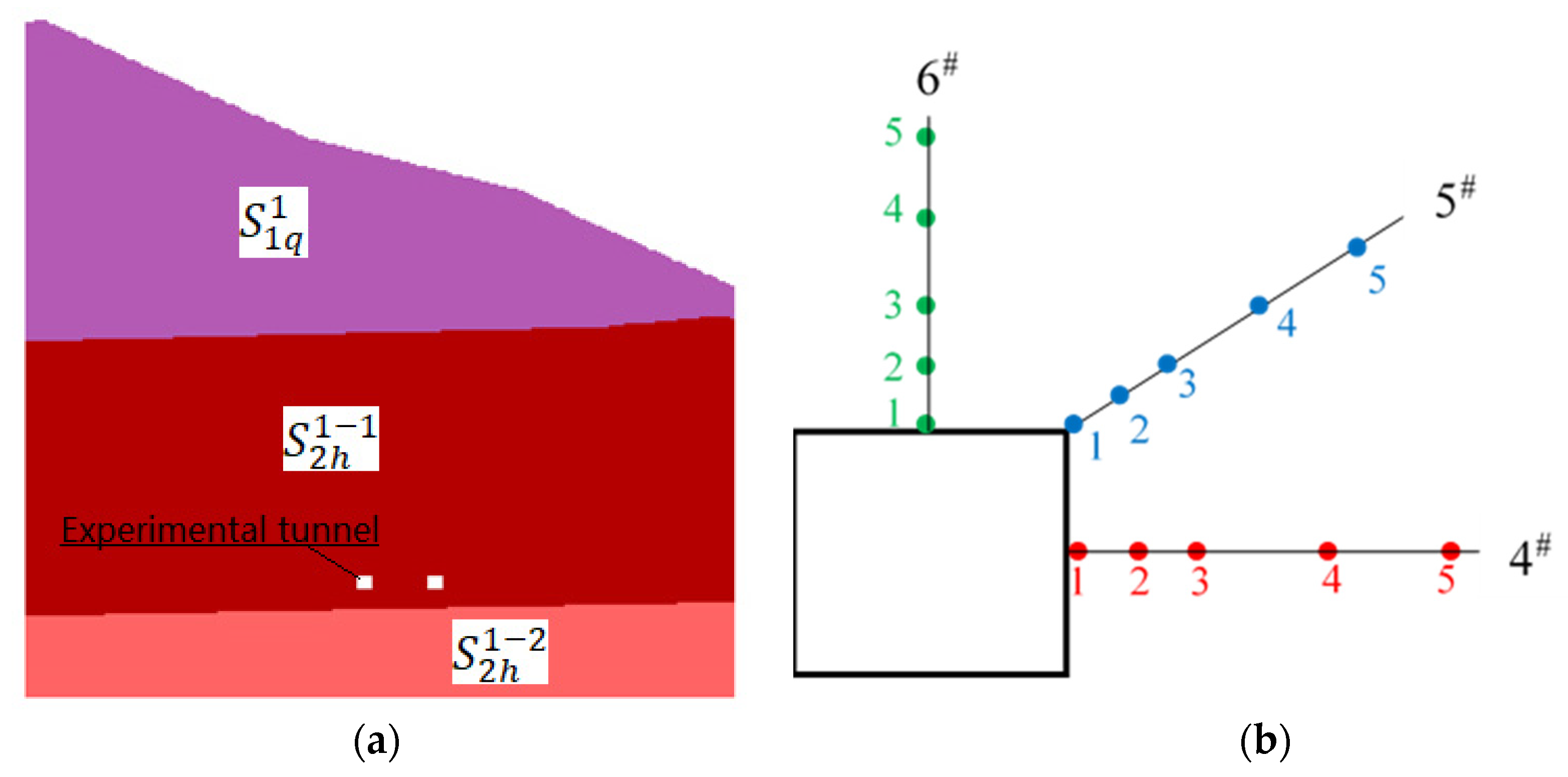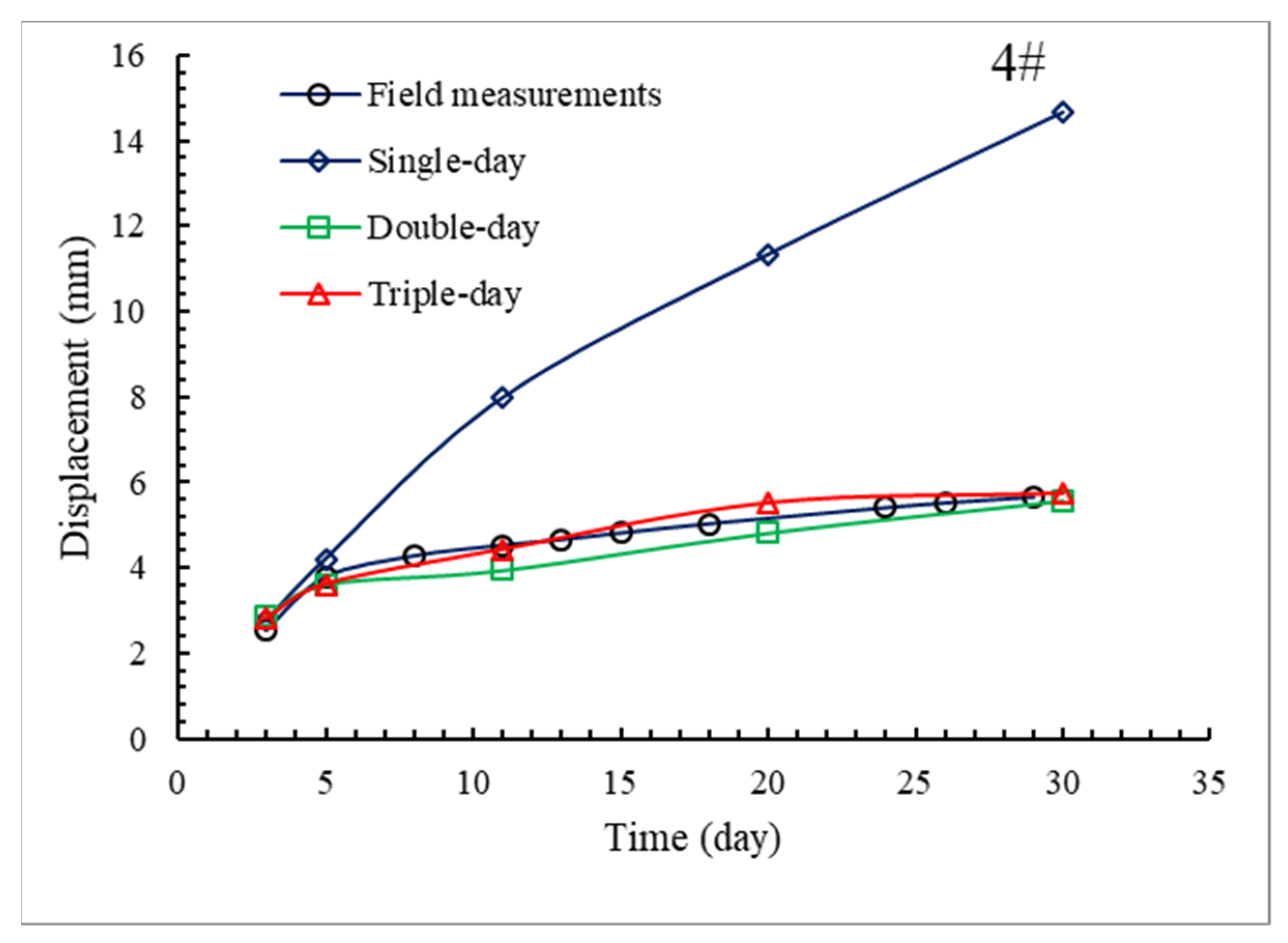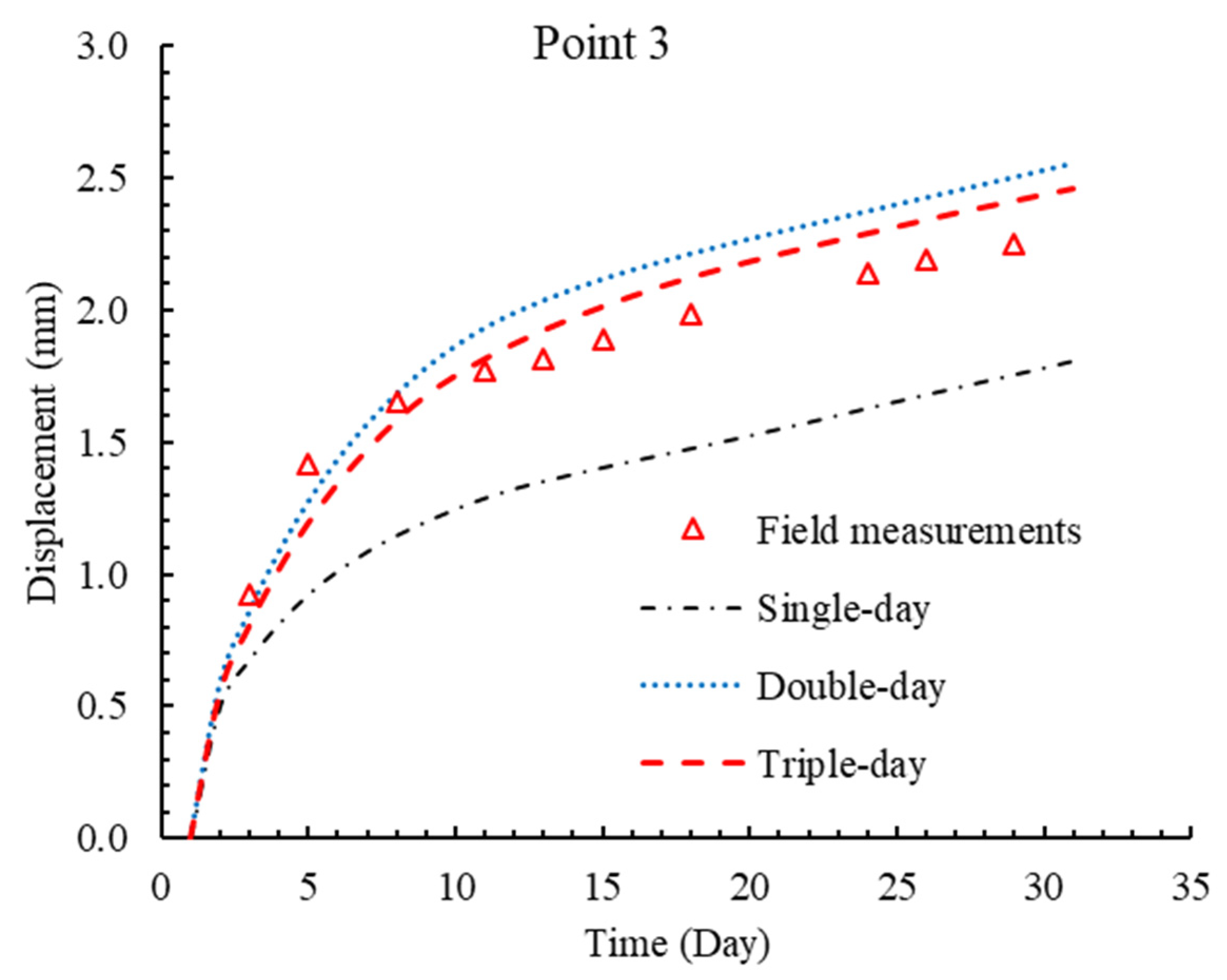AdaBoost-Based Back Analysis for Determining Rock Mass Mechanical Parameters of Claystones in Goupitan Tunnel, China
Abstract
:1. Introduction
2. Methodology
2.1. Surrogate Model Derivation with AdaBoost Technique
2.2. SHGO-Based Optimization
- Uniform sampling point generation in the search space;
- Construction of the directed simplicial complex;
- Construction of the minimizer pool;
- Local minimization using the starting points defined in the minimizer pool.
2.3. Procedures of Proposed Framework
- Step 1: Collect the project information.
- Step 2: Generate the training data based on numerical simulation via the experimental design. The training data consist of not only the numerical model configurations but also the rheological responses.
- Step 3: Derive the surrogate model based on AdaBoost algorithm to capture the nonlinear relationship between the mechanical parameters of surrounding rock mass and the corresponding responses during excavation.
- Step 4: Conduct the optimization via SHGO based on RMS objective function. Then the most likely representative mechanical properties can be obtained. Then the results can be applied in the stability analysis, design scheme optimization, and other works.
3. Application
3.1. Project Overview
3.2. Surrogate Model Derivation
3.3. Back-Analysis
3.4. Discussion
4. Conclusions
Author Contributions
Funding
Institutional Review Board Statement
Informed Consent Statement
Data Availability Statement
Conflicts of Interest
References
- Zhao, H.; Chen, B.; Li, S.; Li, Z.; Zhu, C. Updating the Models and Uncertainty of Mechanical Parameters for Rock Tunnels Using Bayesian Inference. Geosci. Front. 2021, 12, 101198. [Google Scholar] [CrossRef]
- Ledesma, A.; Gens, A.; Alonso, E.E. Parameter and Variance Estimation in Geotechnical Backanalysis Using Prior Information. Int. J. Numer. Anal. Methods Geomech. 1996, 20, 119–141. [Google Scholar] [CrossRef]
- Sakurai, S. Back Analysis in Rock Engineering Practice; CRC Press: Boca Raton, FL, USA, 2017; ISBN 9781317481942. [Google Scholar]
- Azarafza, M.; Akgün, H.; Asghari-Kaljahi, E. Stochastic Geometry Model of Rock Mass Fracture Network in Tunnels. Q. J. Eng. Geol. Hydrogeol. 2018, 51, 379–386. [Google Scholar] [CrossRef]
- Hwang, S.; Choi, S.-K. Deep Learning-Based Surrogate Modeling via Physics-Informed Artificial Image (PiAI) for Strongly Coupled Multidisciplinary Engineering Systems. Knowl.-Based Syst. 2021, 232, 107446. [Google Scholar] [CrossRef]
- Zhao, H.; Chen, B. Inverse Analysis for Rock Mechanics Based on a High Dimensional Model Representation. Inverse Probl. Sci. Eng. 2021, 80, 6429–6443. [Google Scholar] [CrossRef]
- Zhang, W.; Zhang, R.; Wu, C.; Goh, A.T.C.; Lacasse, S.; Liu, Z.; Liu, H. State-of-the-Art Review of Soft Computing Applications in Underground Excavations. Geosci. Front. 2020, 11, 1095–1106. [Google Scholar] [CrossRef]
- Zhao, H. A Practical and Efficient Reliability-Based Design Optimization Method for Rock Tunnel Support. Tunn. Undergr. Sp. Technol. Inc. Trenchless Technol. Res. 2022, 127, 104587. [Google Scholar] [CrossRef]
- Ren, J.; Zhang, L.; Zhao, H.; Zhao, Z.; Wang, S. Determination of the Fatigue Equation for the Cement-Stabilized Cold Recycled Mixtures with Road Construction Waste Materials Based on Data-Driven. Int. J. Fatigue 2022, 158, 106765. [Google Scholar] [CrossRef]
- Feng, X.T.; Zhang, Z.; Sheng, Q. Estimating Mechanical Rock Mass Parameters Relating to the Three Gorges Project Permanent Shiplock Using an Intelligent Displacement Back Analysis Method. Int. J. Rock Mech. Min. Sci. 2000, 37, 1039–1054. [Google Scholar] [CrossRef]
- Itasca FLAC Fast Lagrangian Analysis of Continua, v. 3.3. User’s Manual; Itasca Consulting Group, Inc.: Minneapolis, MN, USA, 1995. [Google Scholar]
- Pichler, B.; Lackner, R.; Mang, H.A. Back Analysis of Model Parameters in Geotechnical Engineering by Means of Soft Computing. Int. J. Numer. Methods Eng. 2003, 57, 1943–1978. [Google Scholar] [CrossRef]
- Yu, Y.; Zhang, B.; Yuan, H. An Intelligent Displacement Back-Analysis Method for Earth-Rockfill Dams. Comput. Geotech. 2007, 34, 423–434. [Google Scholar] [CrossRef]
- Feng, X.T.; Zhao, H.; Li, S. A New Displacement Back Analysis to Identify Mechanical Geo-Material Parameters Based on Hybrid Intelligent Methodology. Int. J. Numer. Anal. Methods Geomech. 2004, 28, 1141–1165. [Google Scholar] [CrossRef]
- Zhao, H.; Ru, Z.; Yin, S. A Practical Indirect Back Analysis Approach for Geomechanical Parameters Identification. Mar. Georesources Geotechnol. 2015, 33, 212–221. [Google Scholar] [CrossRef]
- Zhang, W.; Wu, C.; Zhong, H.; Li, Y.; Wang, L. Prediction of Undrained Shear Strength Using Extreme Gradient Boosting and Random Forest Based on Bayesian Optimization. Geosci. Front. 2021, 12, 469–477. [Google Scholar] [CrossRef]
- Zhao, Z.; Gong, Q.; Zhang, Y.; Zhao, J. Prediction Model of Tunnel Boring Machine Performance by Ensemble Neural Networks. Geomech. Geoengin. 2007, 2, 123–128. [Google Scholar] [CrossRef]
- Barzegar, R.; Sattarpour, M.; Deo, R.; Fijani, E.; Adamowski, J. An Ensemble Tree-Based Machine Learning Model for Predicting the Uniaxial Compressive Strength of Travertine Rocks. Neural Comput. Appl. 2020, 32, 9065–9080. [Google Scholar] [CrossRef]
- Yin, X.; Liu, Q.; Pan, Y.; Huang, X.; Wu, J.; Wang, X. Strength of Stacking Technique of Ensemble Learning in Rockburst Prediction with Imbalanced Data: Comparison of Eight Single and Ensemble Models. Nat. Resour. Res. 2021, 30, 1795–1815. [Google Scholar] [CrossRef]
- Zhang, W.; Li, H.; Han, L.; Chen, L.; Wang, L. Slope Stability Prediction Using Ensemble Learning Techniques: A Case Study in Yunyang County, Chongqing, China. J. Rock Mech. Geotech. Eng. 2022; in press. [Google Scholar] [CrossRef]
- Azarafza, M.; Nanehkaran, Y.A.; Rajabion, L.; Akgün, H.; Rahnamarad, J.; Derakhshani, R.; Raoof, A. Application of the Modified Q-Slope Classification System for Sedimentary Rock Slope Stability Assessment in Iran. Eng. Geol. 2020, 264, 105349. [Google Scholar] [CrossRef]
- Freund, Y.; Schapire, R.E. A Decision-Theoretic Generalization of On-Line Learning and an Application to Boosting. J. Comput. Syst. Sci. 1997, 55, 119–139. [Google Scholar] [CrossRef] [Green Version]
- Liu, Q.; Wang, X.; Huang, X.; Yin, X. Prediction Model of Rock Mass Class Using Classification and Regression Tree Integrated AdaBoost Algorithm Based on TBM Driving Data. Tunn. Undergr. Sp. Technol. 2020, 106, 103595. [Google Scholar] [CrossRef]
- Ren, J.; Zhao, H.; Zhang, L.; Zhao, Z.; Xu, Y.; Cheng, Y.; Wang, M.; Chen, J.; Wang, J. Design Optimization of Cement Grouting Material Based on Adaptive Boosting Algorithm and Simplicial Homology Global Optimization. J. Build. Eng. 2022, 49, 104049. [Google Scholar] [CrossRef]
- Zhao, H.; Yin, S. Inverse Analysis of Geomechanical Parameters by the Artificial Bee Colony Algorithm and Multi-Output Support Vector Machine. Inverse Probl. Sci. Eng. 2016, 24, 1266–1281. [Google Scholar] [CrossRef]
- Zhao, H.; Yin, S. Geomechanical Parameters Identification by Particle Swarm Optimization and Support Vector Machine. Appl. Math. Model. 2009, 33, 3997–4012. [Google Scholar] [CrossRef]
- Sadoghi Yazdi, J.; Kalantary, F.; Sadoghi Yazdi, H. Calibration of Soil Model Parameters Using Particle Swarm Optimization. Int. J. Geomech. 2012, 12, 229–238. [Google Scholar] [CrossRef]
- Endres, S.C.; Sandrock, C.; Focke, W.W. A Simplicial Homology Algorithm for Lipschitz Optimisation. J. Glob. Optim. 2018, 72, 181–217. [Google Scholar] [CrossRef] [Green Version]
- Cai, M.; Morioka, H.; Kaiser, P.K.; Tasaka, Y.; Kurose, H.; Minami, M.; Maejima, T. Back-Analysis of Rock Mass Strength Parameters Using AE Monitoring Data. Int. J. Rock Mech. Min. Sci. 2007, 44, 538–549. [Google Scholar] [CrossRef]
- Tu, C.; Liu, H.; Xu, B. AdaBoost Typical Algorithm and Its Application Research. MATEC Web Conf. 2017, 139, 00222. [Google Scholar] [CrossRef]
- Drucker, H. Improving Regressors Using Boosting Techniques. In Proceedings of the 14th International Conference on Machine Learning, San Francisco, CA, USA, 8–12 July 1997; pp. 107–115. [Google Scholar]
- Virtanen, P.; Gommers, R.; Oliphant, T.E.; Haberland, M.; Reddy, T.; Cournapeau, D.; Burovski, E.; Peterson, P.; Weckesser, W.; Bright, J.; et al. {SciPy} 1.0: Fundamental Algorithms for Scientific Computing in Python. Nat. Methods 2020, 17, 261–272. [Google Scholar] [CrossRef] [Green Version]
- Chen, B.R. Back Analysis of Rheological Parameters of Rock Mass Using Intelligent Method; Northeastern University: Shenyang, China, 2003. [Google Scholar]
- Itasca Consulting Group, Inc. FLAC—Fast Lagrangian Analysis of Continua, Ver. 8.1; Itasca Consulting Group, Inc.: Minneapolis, MN, USA, 2019. [Google Scholar]
- Fahimifar, A.; Tehrani, F.M.; Hedayat, A.; Vakilzadeh, A. Analytical Solution for the Excavation of Circular Tunnels in a Visco-Elastic Burger’s Material under Hydrostatic Stress Field. Tunn. Undergr. Sp. Technol. 2010, 25, 297–304. [Google Scholar] [CrossRef]
- Goodman, R.E. Introduction to Rock Mechanics, 2nd ed.; John Wiley & Sons: New York, NY, USA, 1989; ISBN 0471812005. [Google Scholar]










| Time (Day) | Displacement (mm) | ||
|---|---|---|---|
| 4# | 5# | 6# | |
| 3 | 2.558 | 2.441 | 1.778 |
| 5 | 3.789 | 3.681 | 2.377 |
| 8 | 4.281 | 4.094 | 2.6 |
| 11 | 4.531 | 4.308 | 2.685 |
| 13 | 4.662 | 4.434 | 2.84 |
| 15 | 4.816 | 4.521 | 2.907 |
| 18 | 5.026 | 4.522 | 3.026 |
| 24 | 5.406 | 4.986 | 3.256 |
| 26 | 5.514 | - | - |
| 29 | 5.646 | 5.13 | 3.348 |
| 34 | 6.222 | 5.621 | 3.636 |
| 39 | 6.411 | 5.799 | 3.751 |
| 42 | 6.544 | 5.88 | 3.788 |
| 45 | 6.658 | 5.952 | 3.812 |
| Clay-Green Clay Rock | Purple Clay Rock | ||||||
|---|---|---|---|---|---|---|---|
| G1h (GPa) | G2h (GPa) | η2h(GPad) | η1h(GPad) | G1z (GPa) | G2z (GPa) | η2z(GPad) | η1z(103GPad) |
| 0.5–4.5 | 0.1–3.5 | 0.1–3.5 | 15–35 | 1–15 | 5–20 | 1–15 | 1.5–4.5 |
| Layer | Rheological Properties | Field Data | ||
|---|---|---|---|---|
| Single-Day | Double-Day | Triple-Day | ||
| Clay-green clay rock | G1h (GPa) | 4.6875 | 4.3125 | 2.9063 |
| G2h (GPa) | 0.1531 | 0.4719 | 0.3391 | |
| η2h (GPad) | 1.3219 | 0.5781 | 0.4984 | |
| η1h (GPad) | 31.5625 | 28.1875 | 30.7813 | |
| Purple clay rock | G1z (GPa) | 7.3438 | 13.0313 | 14.2344 |
| G2z (GPa) | 19.3594 | 10.3906 | 14.9609 | |
| η2z (GPad) | 8.2188 | 3.4063 | 1.9844 | |
| η1z (103GPad) | 4.2656 | 3.2344 | 2.4141 | |
Publisher’s Note: MDPI stays neutral with regard to jurisdictional claims in published maps and institutional affiliations. |
© 2022 by the authors. Licensee MDPI, Basel, Switzerland. This article is an open access article distributed under the terms and conditions of the Creative Commons Attribution (CC BY) license (https://creativecommons.org/licenses/by/4.0/).
Share and Cite
Zhao, H.; Zhang, L.; Ren, J.; Wang, M.; Meng, Z. AdaBoost-Based Back Analysis for Determining Rock Mass Mechanical Parameters of Claystones in Goupitan Tunnel, China. Buildings 2022, 12, 1073. https://doi.org/10.3390/buildings12081073
Zhao H, Zhang L, Ren J, Wang M, Meng Z. AdaBoost-Based Back Analysis for Determining Rock Mass Mechanical Parameters of Claystones in Goupitan Tunnel, China. Buildings. 2022; 12(8):1073. https://doi.org/10.3390/buildings12081073
Chicago/Turabian StyleZhao, Hongbo, Lin Zhang, Jiaolong Ren, Meng Wang, and Zhiqiang Meng. 2022. "AdaBoost-Based Back Analysis for Determining Rock Mass Mechanical Parameters of Claystones in Goupitan Tunnel, China" Buildings 12, no. 8: 1073. https://doi.org/10.3390/buildings12081073
APA StyleZhao, H., Zhang, L., Ren, J., Wang, M., & Meng, Z. (2022). AdaBoost-Based Back Analysis for Determining Rock Mass Mechanical Parameters of Claystones in Goupitan Tunnel, China. Buildings, 12(8), 1073. https://doi.org/10.3390/buildings12081073







